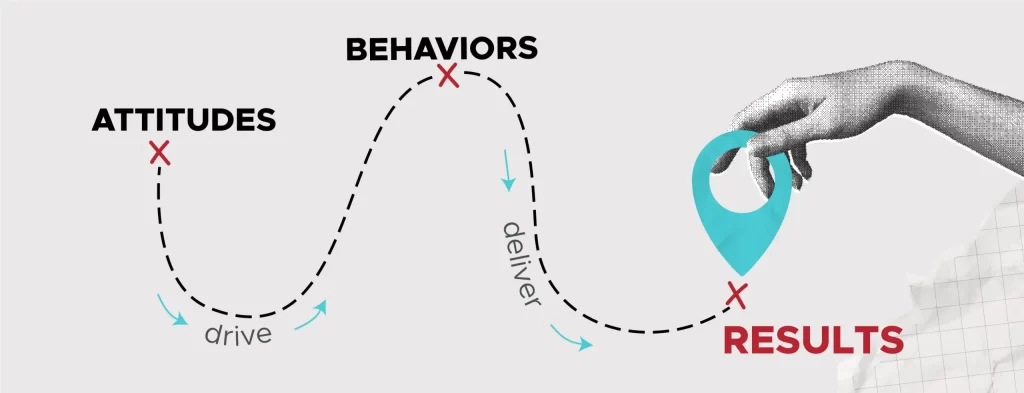Customer experience is the sum of all experiences a consumer has with a supplier of goods or services, throughout their relationship with your brand. The customer journey map provides a comprehensive overview of all touchpoints between individuals and your brand.

What Is A Customer Journey Map (CJM)?
What Is A Customer Journey Map (CJM)?

CJM is a visual representation of how customers currently experience a product or service. By examining the present interactions, it helps identify friction points that may be causing customer attrition.
Most customer journey maps are typically structured in chronological order, depicting the customer experience as a sequence of events over time. Instead, customers often navigate a cyclical and multichannel process when interacting with your business. For instance, they might make purchases both online and offline simultaneously if both options are available.
Benefits Of A Customer Journey Map
Benefits Of A Customer Journey Map
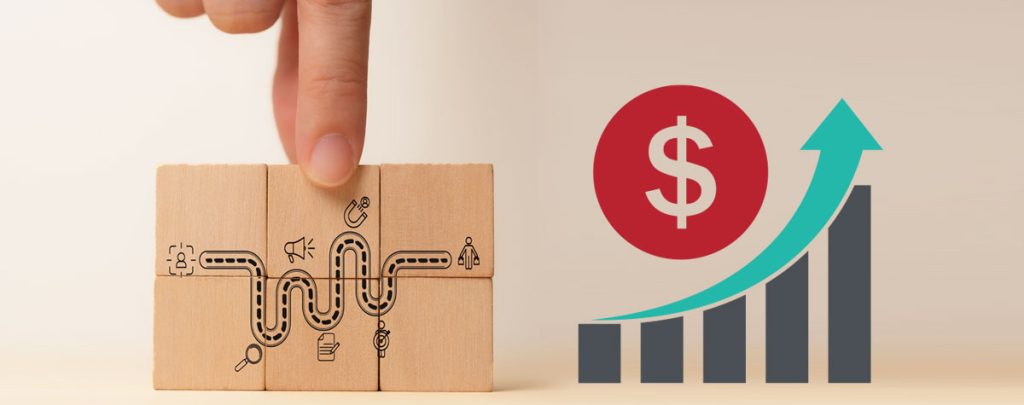
It is crucial to grasp your customers’ experiences to stay ahead of evolving needs, technology, and market shifts. According to Hanover Research, 79% of companies that allocate resources to customer journey maps indicate a resulting increase in customer-centricity, and the following benefits:
- Gain valuable customer insights
- Boost customer engagement & revenue
- Enhance customer retention
- Streamline ineffective touchpoints
- Prioritize customer focus
- Attract new business
- Break down business silos
How To Create A Customer Journey Map
Creating a customer journey map involves a series of steps as outlined below. Following these steps will help ensure that the end result effectively delivers the desired benefits.
1. Establish clear objectives for the map

It’s important to define the specific objectives you aim to achieve through the map, identify the target customers, and determine the types of experiences the map should highlight. Additionally, align the goals for creating the customer journey with the overall company objectives, such as increased revenue or improved customer retention. It’s essential to establish relevant metrics to measure the goals effectively.
Take a hands-on approach to identify the “Four I’s”:
- Insights – a clear understanding of customer needs.
- Impact – clear focus on the resulting business value.
- Issues/Opportunities – what’s getting in the way, or could be improved, to meet customer needs.
- Innovate – design solutions that deliver both customer and organisational value.
We want you to have a clear understanding of your customer’s needs at both a functional level and an emotional level. This is not about getting better customer satisfaction scores. This is about driving revenue and operating income. What we’re trying to do is to identify the issues or opportunities that are getting in the way of us delivering those experiences which will meet the needs of the customer.
2. Create customer personas and define their goals

Based on the gathered data, identify the customer personas to target in the maps. If necessary, update or develop personas using surveys, interviews, testimonials, and feedback from customer relations teams. The more specific details collected about customer preferences and needs, the more effective the customer journey maps will be.
3. Map a customer’s step-by-step experience
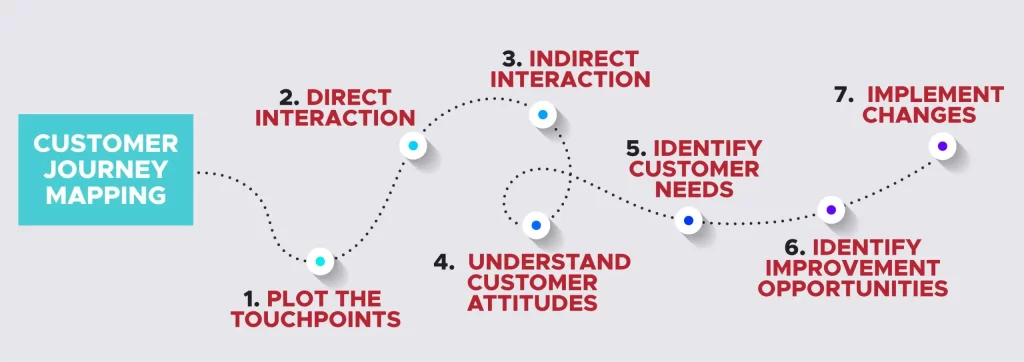
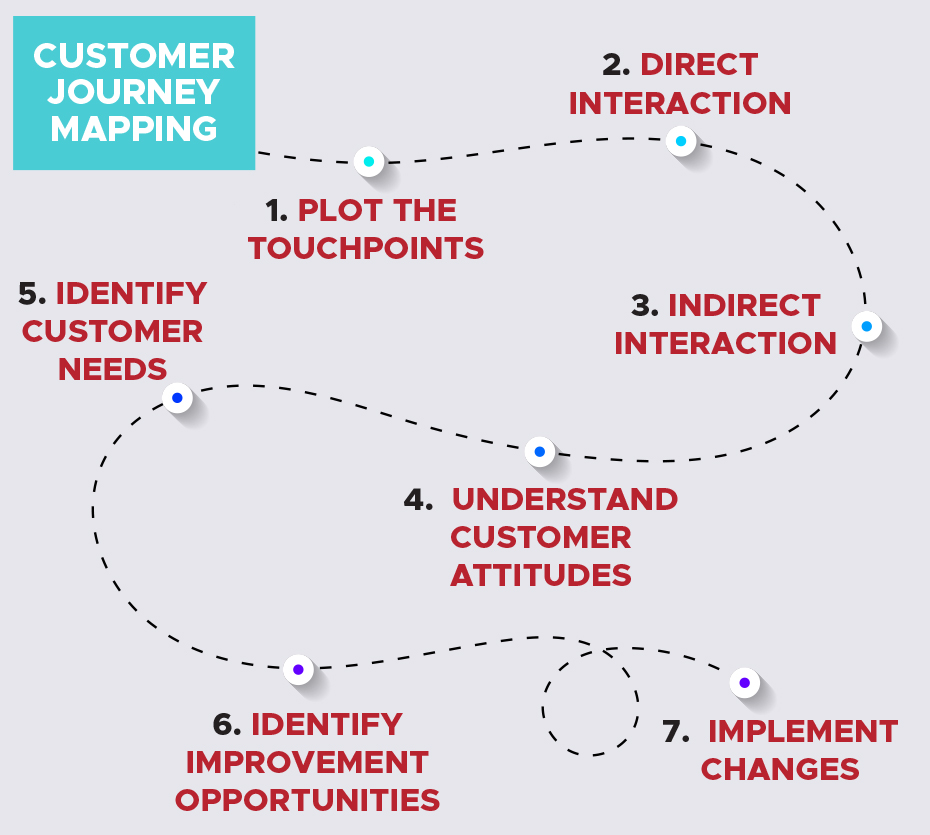
1. Plot the Touchpoints
After identifying your customer’s touchpoints/steps/behaviors, map the steps that buyers go through when making purchases. Recognise all engagement points between customers and your brand. These touchpoints encompass direct and indirect interactions with the business, including third-party site reviews. It’s crucial to consider all touchpoints as they can influence customer conversion.
2. Direct Interaction (on stage)
List all of the People and Things that your customer comes into direct contact with at each touchpoint – We call this onstage. We like this to a theatre analogy – the actors and props that the audience sees are on stage.
3. Indirect Interaction (backstage)
Next map the People and Things backstage, which support the things backstage. Your customer doesn’t come into direct contact with these people and things. Continuing the theatre analogy, this might be the set designer, lighting technicians, or sound system. EG: When a patient arrives at the hospital, the receptionist is using a patient record system. That record system may have an administrator. Making assumptions on backend systems is fine.
4. Understand Customer Attitudes
After mapping out the step-by-step experience, we want to understand the customer’s attitudes and each touch point. Write them as if it’s a thought in your customer’s head. Channel your inner customer.
5. Identify Customer Needs
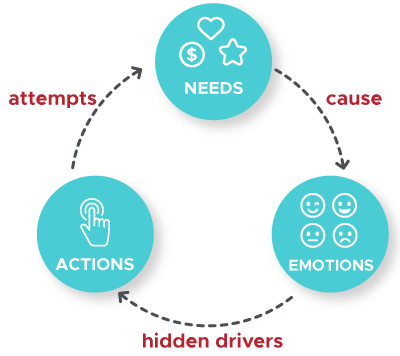
When mapping customer needs, it’s important that we map two levels of needs:
(1) Moment Need
(2) Emotional Need
Often, we can quickly come up with moment needs but may struggle a little with emotional needs. Interestingly enough understanding moment needs helps bring out emotional needs. Focusing on that moment, seek to understand WHY that moment happened. Use empathy to understand how your customers’ needs/goals are affected at that moment/step.
6. Identify Improvement Opportunities
During a customer journey mapping exercise we are focused on:
- Mapping to understand & diagnose experience issues
- Using maps to reframe and reimagine experiences
- Redesigning experiences to influence attitudes
- Leveraging mapping to connect, collaborate, & align

Identifying systemic issues (opportunities) worth addressing is related to the customers’ needs that are not being met.
We then want to intentionally re-configure our processes or our offering to meet those needs that are not being met. Using this newfound understanding, we set out to reframe the experience problem.
It’s challenging to directly change a person’s attitude or emotions. So, you focus on the aspects of the journey that you can influence – remember Influencing attitudes leads to changes in behaviors.
Re-map to positively influence your customer’s emotions, attitudes, and experience at the moment that matters. Across the journey, we want to be changing attitudes to drive new behavior to deliver new results…
7. Implement the required changes.
It may seem obvious to make these changes before launching, but it can be challenging if you’re already falling behind your original schedule.
The temptation might be to release the current version and make improvements over time. However, doing so could frustrate customers who may not return to see the planned enhancements.
How to get it right the first time?
Ensure a successful construction of your new map by avoiding false starts and dead ends. Instead, maximize its potential reach and profitability by implementing each of these best practices.
Establish a clear goal for the customer journey map, outlining what you hope to achieve, which customers you are targeting, and the types of experiences you want to highlight.
It’s important to also define relevant metrics to track as you create and use your customer journey maps. Setting clear goals is ineffective without a standard for measuring them.
Make the customer journey map accessible to cross-functional teams to defeat information silos and increase employee buy-in. Distribute it widely within your organization early in the process to allow input from other teams, and again upon completion for the most effective map possible.
Take the 1st step to creating a brand experience that will last a lifetime
Just say the word and get started on:
- Redesigning your customer’s experience to influence a change towards the desired attitudes that you want to see.
- Driving the new behaviours that will deliver the high-performance marketing ROI, sales and customer satisfaction.
Let’s Start a conversation by completing the form below.



